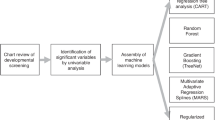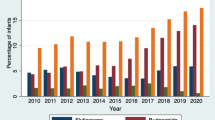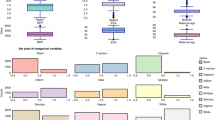Abstract
We report a 3½-month-old infant with trisomy 21 presenting with galactorrhea in the neonatal intensive care unit (NICU). Endocrine work-up showed a high prolactin level (64.4 ng ml−1—normal: 0.5 to 30 ng ml−1). Cessation of therapy with metoclopramide (0.2 mg kg−1 per dose q 6 h) resulted in the resolution of galactorrhea with a decrease in serum prolactin level (20.1 ng ml−1). We present this case to highlight this uncommon side effect of a commonly used medication in the NICU.
Similar content being viewed by others

Introduction
Galactorrhea in the newborn (sometimes referred to as ‘witch's milk’) was first described in the medical literature in the seventeenth century.1 It is a common condition and is seen in ∼5 to 6% of term infants with no gender preponderance.2 This condition is considered physiologic, secondary to withdrawal from maternal hormones after birth. Most of these infants present during the first week of life (between the fifth and seventh days of life) followed by a spontaneous resolution in a few weeks.3 Galactorrhea is uncommon in infants beyond 3 months of age. We describe a 3½-month-old infant who developed galactorrhea in the neonatal intensive care unit (NICU) after metoclopramide therapy.
Case
A term male neonate, with trisomy 21, with patent ductus arteriosus, stridor, and feeding intolerance was evaluated by a pediatric otorhinolaryngologist at 40 days of age. Laryngomalacia, glottic edema, and erythema were observed on flexible laryngoscopy. He was suspected to have gastroesophageal reflux-induced irritation of the airway, and was treated with metoclopramide at 0.15 mg kg−1 per dose every 8 h for 45 days. He underwent surgical closure of a patent ductus arteriosus at 1 month of life. His stay in the NICU was prolonged because of his poor ability to tolerate oral feeds and stridor. Owing to persistent stridor and respiratory distress, he was started on lansoprazole at 1.5 mg kg−1 per dose every 24 h and his metoclopramide dose was increased to 0.2 mg kg−1 per dose every 6 h (maximum dose in the standard pediatric reference handbook4). There was no improvement in the symptoms despite the escalation of metoclopramide dosage. He underwent an emergent tracheostomy at 3 months of age due to his deteriorating respiratory status because of subglottic narrowing. He was continued on metoclopramide to enhance gastric emptying. Two weeks after treatment with metoclopramide at 0.8 mg kg−1 per day, he was noted to have prominent breasts (asymmetric gynecomastia, right greater than left) with milk discharge. Endocrine work-up showed a normal thyroid profile (T4 1.67 ng per 100 ml, TSH 5.24 IU ml−1). Serum HCG (negative), estradiol (<20 pg ml−1), FSH (4.6 mIU ml−1), and LH (7 mIU ml−1) were within normal limits. Scrotal ultrasound was normal with both testes present. Serum prolactin level was elevated at 56.8 ng ml−1 (normal range—0.5 to 30 ng ml−1). When this report was received, a repeat prolactin level was checked immediately and was again high at 64.4 ng ml−1. Metoclopramide was discontinued. Gynecomastia and galactorrhea resolved within 1 week. Repeat prolactin level was within normal limits (20.6 ng ml−1) 2 weeks after discontinuing metoclopramide.
Discussion
Lactation, as opposed to breast gland proliferation, is inhibited during pregnancy by high levels of the circulating progesterone. Progesterone withdrawal occurs around the time of delivery in association with a continuing increase in prolactin levels, which initiates milk secretion in the mother.5 These changes in maternal hormones may result in bilateral breast hypertrophy and galactorrhea in infants. Prolactin levels are elevated markedly in cord blood at 170 ng ml−1 compared with adults (<20 ng ml−1) and are declined by >60% in the first week after birth.6, 7
The regulation of prolactin is unique because it is secreted consistently unless it is inhibited actively by dopamine (also called the prolactin inhibitory factor), which is produced by neurons in the hypothalamus.8 Dopamine antagonists may result in increased serum levels of prolactin. Metoclopramide is a dopamine antagonist and is used commonly as a prokinetic drug to treat gastroesophageal reflux disease in infants.9, 10, 11 Its gastrointestinal smooth muscle stimulatory effects are related to its ability to antagonize the inhibitory neurotransmitter dopamine and to augment acetylcholine release. In adults, metoclopramide has been reported to cause gynecomastia and galactorrhea from hyperprolactinemia.12 In fact, it is prescribed to improve faltering milk production in mothers of premature infants.13
The efficacy of metoclopramide with a dose range of 0.1–0.3 mg kg−1 per dose in gastroesophageal reflux has been studied in infants.14, 15 Two recent reviews have concluded that evidence for the safety and the efficacy of metoclopramide in infants for gastroesophageal reflux is inconclusive.9, 16 The only other case report of metoclopramide-induced galactorrhea in infants involved an infant with chondrodysplasia punctata.17 Similar to our patient, this infant was on a dose of 0.2 mg kg−1 four times a day and had a high prolactin level (37 ng ml−1). This dose is higher than that recommended (0.033 to 0.1 mg kg−1 per dose every 8 h) in a standard neonatal reference.18 It is interesting that the daily dose in the earlier case report and our patient (0.8 mg kg−1 per day) exceeded the dose recommended in this reference, suggesting a dose-related effect without any evidence of added benefit. Similar reports of galactorrhea in infants after the use of domperidone (a prokinetic agent not available in the United States) are present in the literature.19
We conclude that careful physical examination of breast tissue must be performed in infants on prolonged or high-dose therapy with metoclopramide. If evidence of gynecomastia or galactorrhea is found, prolactin levels should be obtained. If these levels are high, attempts to discontinue or reduce the dose of metoclopramide should be considered. An awareness of this reversible side effect of metoclopramide will result in prompt diagnosis preventing an extensive endocrine work-up and reducing parental anxiety.
References
Forbes TR . Witch's milk and witches’ marks. Yale J Biol Med 1950; 22: 219–225.
Madlon-Kay DJ . ‘Witch's milk’. Galactorrhea in the newborn. Am J Dis Child 1986; 140: 252–253.
McKiernan JF, Hull D . Breast development in the newborn. Arch Dis Child 1981; 56: 525–529.
Lee C, Robertson J, Shilkofski N . Drug doses—The Harriet Lane Handbook, 17th edn. Elsevier Mosby: Philadelphia, 2005.
McKiernan JF, Hull D . Prolactin, maternal oestrogens, and breast development in the newborn. Arch Dis Child 1981; 56: 770–774.
Gluckman PD, Ballard PL, Kaplan SL, Liggins GC, Grumbach MM . Prolactin in umbilical cord blood and the respiratory distress syndrome. J Pediatr 1978; 93: 1011–1014.
Sultan C, Bonardet A, Bonnal B, Descomps B, De Kerleau JC, Bonnet H et al. [Plasma prolactin levels in normal children from birth to adolescence]. C R Seances Soc Biol Fil 1977; 171: 131–135.
Parks JS, Felner EI . Hormones of the hypothalamus and pituitary. In: Kliegman RM, Behrman RE, Jenson HB, Stanton BF (eds). Nelson Textbook of Pediatrics. Elsievier: Philadelphia, 2007.
Hibbs AM, Lorch SA . Metoclopramide for the treatment of gastroesophageal reflux disease in infants: a systematic review. Pediatrics 2006; 118: 746–752.
Clark RH, Bloom BT, Spitzer AR, Gerstmann DR . Reported medication use in the neonatal intensive care unit: data from a large national data set. Pediatrics 2006; 117: 1979–1987.
Malcolm WF, Gantz M, Martin RJ, Goldstein RF, Goldberg RN, Cotten CM . Use of medications for gastroesophageal reflux at discharge among extremely low birth weight infants. Pediatrics 2008; 121: 22–27.
Arroyo H, Aubert L . [Galactorrhoea following metoclopramide treatment]. Presse Med 1971; 79: 1859.
Ehrenkranz RA, Ackerman BA . Metoclopramide effect on faltering milk production by mothers of premature infants. Pediatrics 1986; 78: 614–620.
Hyams JS, Leichtner AM, Zamett LO, Walters JK . Effect of metoclopramide on prolonged intraesophageal pH testing in infants with gastroesophageal reflux. J Pediatr Gastroenterol Nutr 1986; 5: 716–720.
Tolia V, Calhoun J, Kuhns L, Kauffman RE . Randomized, prospective double-blind trial of metoclopramide and placebo for gastroesophageal reflux in infants. J Pediatr 1989; 115: 141–145.
Craig WR, Hanlon-Dearman A, Sinclair C, Taback S, Moffatt M . Metoclopramide, thickened feedings, and positioning for gastro-oesophageal reflux in children under two years. Cochrane Database Syst Rev 2004 CD003502.
Madani S, Tolia V . Gynecomastia with metoclopramide use in pediatric patients. J Clin Gastroenterol 1997; 24: 79–81.
Young T, Mangum B . Neofax 2008. Thomson Reuters Healthcare: Montvale, NJ, 2008; 8: 222.
van der Steen M, Du Caju MV, Van Acker KJ . Gynecomastia in a male infant given domperidone. Lancet 1982; 2: 884–885.
Author information
Authors and Affiliations
Corresponding author
Rights and permissions
About this article
Cite this article
Paturi, B., Ryan, R., Michienzi, K. et al. Galactorrhea with metoclopramide use in the neonatal unit. J Perinatol 29, 391–392 (2009). https://doi.org/10.1038/jp.2008.246
Received:
Revised:
Accepted:
Published:
Issue date:
DOI: https://doi.org/10.1038/jp.2008.246


